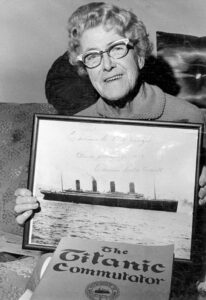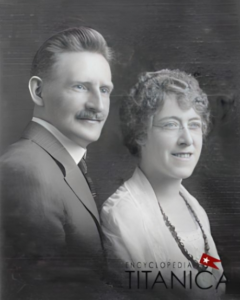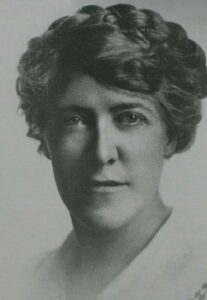by Dennis Dalman
Edwina “Winnie” Troutt was one lucky woman. She not only survived the sinking of the Titanic, she also outlived three husbands, endured a near-deadly bout of pneumonia and then went on to continue living a long productive life, despite having the use of only one lung.
She lived to be 100, dying on Dec. 3, 1984.
Troutt was a cousin of the late Bernice Traut, the mother of John Villcheck, a long-time Sartell resident. In an interview with the Newsleader, Villcheck explained that “Traut” is a variable spelling of “Troutt.” The name was changed to “Traut” by many of the Troutt relations during World War II, Villcheck noted.
In 1972, Edwina “Winnie” Celia Troutt traveled from southern California to central Minnesota to attend a multi-family reunion in St. Stephen. The reunion was hosted by members of the Traut and Supan families, many of whom are related. As far as Villcheck can remember, that was the only time Troutt visited central Minnesota.
Coal strike
On April 10, 1912, Edwina Troutt (born in 1884 in Bath, England and raised in that city), arrived in Southampton on the south coast of England for a transatlantic voyage to New York City. There, at the English port, she learned that because of a coal strike in England, the ship she had a ticket for (named the Oceanic) could not sail because it had not enough coal to power the ship for the long journey. Instead, she was allowed to board another passenger ship, one that was called the Titanic, which had plenty of pre-stored coal on board.
Troutt’s plan was to travel to the United States to be with a sister who was about to birth a baby in Auburndale, Mass. where she lived with her American husband. It would not be Troutt’s first visit to America. In 1907, she came to the U.S. and stayed there for nearly five years, working as a pre-school teacher and as a clerk in her brother-in-law’s tobacco shop. She had also worked as a waitress in New Jersey and as a domestic house keeper in Auburndale. She returned to England in 1911.
Cabin 101
At Southampton, a long line of passengers (first class, second class, third class) waited to board the Titanic. Edwina Troutt, 27, was assigned to cabin 101, a second-class accommodation on E deck. She had two cabin-mates – an English woman, Susan Webber; and an Irish woman, Nora Keane.
The Titanic was a magnificent ocean liner, so large and ornate that it had a gymnasium, a large dining area and a ballroom with its grand staircase. The three women were enjoying their voyage, dining and chatting with other passengers.
Nora Keane, however, had some troubling fits of nervousness. She kept telling Troutt that the ship would not make it to New York. A superstitious Irish woman, Keane had accidentally dropped her rosary and prayer book onto the deck when boarding the ship, fearing that was an omen of impending doom. During the voyage, she would quite often tell Troutt that the ship was “not going to make it.”
Journey begins
Recently built in Belfast, Ireland, the Titanic was at that time the largest passenger liner in history. It was also widely touted as “unsinkable” because of its innovative water-proof, double-hull design. The journey from Southampton to New York was its first trip, its “maiden” voyage.
After setting out from England, five days later, on April 15, the unsinkable Titanic sank in the North Atlantic after hitting part of a huge iceberg. It took about three hours for the giant ship to submerge totally beneath the surface to the ocean’s bottom two miles below. It happened east of Newfoundland, a few hundred miles northeast of New York.
The unthinkable, unprecedented disaster sent shock waves throughout the world.
Shuddering ship
On the night of April 15 (11:40 p.m.), Troutt in her cabin was awakened by a loud slam and shuddering vibrations. She put a warm coat over her nightgown and hurried from the cabin to investigate, soon learning the ship was in deep trouble.
Returning to the cabin, she noticed Susan Webber had already left for the deck. A very nervous Nora Keane was trying to put on her corset. Troutt grabbed it from her and flung it across the room, insisting they must leave the cabin immediately.
The ship’s lifeboats, about 20 of them, were already being lowered to be filled with passengers. On the deck, at the edges of the ship, people gathered in the cold night air as women and children were placed into the waiting lifeboats that, once full, were lowered down to the ocean surface.
To Troutt’s great relief, cabin-mates Webber and Keane had managed to find room in two of the lifeboats.
As she waited to board a lifeboat, Troutt saw a man walk quickly toward her. Desperately shaken, he was holding a 5-month-old child he said was his nephew. He asked Troutt if she would please take the boy to save him. She took the child immediately into the lifeboat with her, along with a prayer book and her toothbrush. She later learned the boy’s name was Assad Thomas, a nephew of the man, Charles Thomas, who would perish that night.
As she, the boy and others in the lifeboat were being lowered to the water, Troutt heard the Titanic’s band playing “Nearer, my God, to Thee” in the ship’s ballroom.
Seeing it sink
As the lifeboats floated away on the cold dark water away from the ship, Troutt and the other survivors could see the huge unsinkable ship sinking, tilting up at a steep angle out of the ocean, its many bright lights one by one being extinguished under the waves as it sank down, down slowly but surely until it could be seen no more.
In the lifeboats, some died of injuries or exposure to the cold, but most (710 people, almost all of the women and children) managed to survive, rescued by a big ship called the Carpathia and then taken to Newfoundland.
About 1,500 people – men, women, children, the ship’s crew members – perished in the ice-cold ocean water or went down to the bottom, still inside the ship. Most of those who died were among the third-class passengers.
Slow recovery
Aboard the Carpathia, the nervous, distraught Troutt was placed on a table where she managed to sleep somewhat, fitfully. But the third day after the sinking, a storm caused her to become hysterical. She was given a real bed and some brandy. It would take several months before she would recover emotionally.
Life goes on
In 1916, Troutt moved from Massachusetts to southern California where she joined the Army Corps. Two years later, she married Alfred Thorvald Peterson, and the two operated a bakery in Beverly Hills until his death in 1944. She married James Corrigan. Later, in 1964, she married James MacKenzie. During her retirement years, she lived in Hermosa Beach, Calif. She died at 100 on Dec. 3, 1984 in Redondo Beach, Calif.
During her long life, Troutt frequently talked about her ill-fated voyage on the Titanic in radio and television interviews. Some of those clips can still be seen on YouTube.
On her 90th birthday in 1974, she received a letter from President Richard Nixon.
Troutt’s traumatic experience of the Titanic sinking did not put a stop to her oceanic voyages. She last crossed the Atlantic Ocean to England when she was 99 years old. It was the last of a dozen transatlantic crossings.
(Note: This story was based on an interview with John Villcheck of Sartell, as well as extensive online research, including an article published in “Encyclopedia Titanica,” a massive work dedicated to the victims and the survivors of the Titanic tragedy.)

Late in her life, Edwina “Winnie” Celia Troutt (MacKenzie), holds a photo of the magnificent but doomed passenger liner, the Titanic. She was aboard the ship when it struck an iceberg in the North Atlantic Ocean on April 15, 1912. Troutt survived the disaster and went on to live a long, productive life, living to be 100.

This photo shows the biggest passenger ship in the world, the Titanic, docked in an English port not long before it set out for its doomed transatlantic voyage to New York City from Southampton, England. The ship sank in the North Atlantic Ocean on the night of April 15, 1912. About 1,500 passengers and crew died, but 710 were saved, thanks to lifeboats and the Carpathia ship that came to the rescue of the chilled and traumatized survivors.

Edwina “Winnie” Celia Troutt married Alfred Thorvald Peterson in southern California. Together, they operated a bakery in Beverly Hills. Peterson was the first of Troutt’s three marriages.

Edwina “Winnie” Celia Troutt was born and raised in Bath, England. She was 27 years old when she boarded the Titanic for a voyage to the United States. The ship sank, but she did not. She lived to be 100.




